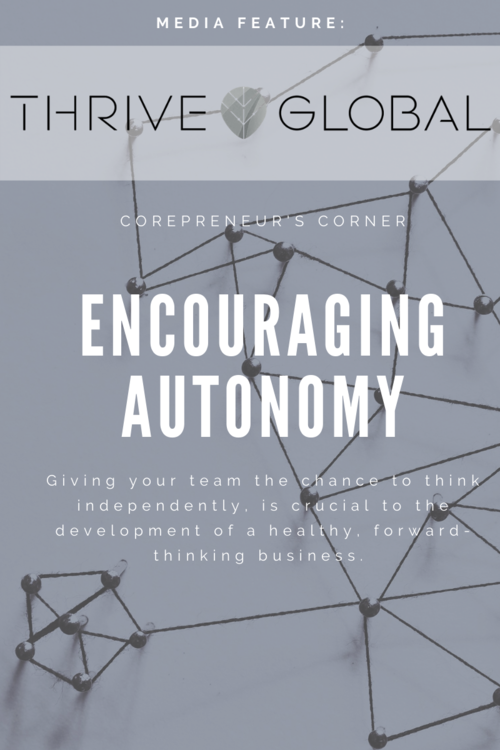Encouraging autonomy. Giving your team the chance to think independently, and trusting that they have the knowledge, experience, and desire to contribute meaningfully, is crucial to the development of a healthy, nimble, and forward-thinking business. For example: before a leader rushes to offer direction, they should sit back and allow their team members the opportunity […]
The Thrive Global Community welcomes voices from many spheres. We publish pieces written by outside contributors with a wide range of opinions, which don’t necessarily reflect our own. Community stories are not commissioned by our editorial team, and though they are reviewed for adherence to our guidelines, they are submitted in their final form to our open platform. Learn more or join us as a community member!
By Ben Ari
Encouraging autonomy. Giving your team the chance to think independently, and trusting that they have the knowledge, experience and desire to contribute meaningfully, is crucial to the development of a healthy, nimble and forward-thinking business. For example: before a leader rushes to offer direction, they should sit back and allow their team members the opportunity to move forward in the way they see fit, empowering them to exercise their creativity and demonstrate their competency.
As a part of our series about “How business leaders can create a fantastic work environment”, I had the pleasure of interviewing Shelisa Bainbridge.
ShelisaB, Inc. helps new and mid-level organizational leaders “Go Off-Script”. Going off-script means thinking, acting, and leading differently; challenging the status quo; asking lots of questions to understand why things are the way they are, and then having the courage to do things differently. Coaching is offered online, one-on-one, through your organization, with single workshop events, or through a public speaking arrangement.
Thank you so much for doing this with us! Can you tell us a story about what brought you to this specific career path?
Absolutely! I think everyone gets to that point in their career where they desire “more” — they want to make more money or feel more fulfilled, or simply enjoy their work and their environment more than they have been.
For some people it happens earlier in their career, sometimes after only having spent a few years working for a company. For others, such as myself, it happens much later.
What did “More” mean for me? It meant being in a position where I would be able to use and apply my strengths (or “superpowers”) more consistently and being in an environment where superpowers were more recognized and celebrated.
I remember a particularly defining moment for me — I was asked to take over a role that required me to interact with one of our internal teams and the client that this team was representing. The leader of the internal team (let’s call her “Pam”) was very sensitive to introducing any new individual to the client. (Side note: I remember originally being excited about this role, because one of my superpowers is being able to establish trust and create relationships quickly.) So at her command, I laid low, but tried hard to convince her that I was the right woman to put in front of the client.
A couple of weeks later, a meeting was set up between Pam, her team, and the client, and I was told by Pam to not attend. But at the direction of my boss (let’s call her “Amy”), I was told to show up regardless. (Awkward!)
So there I was, walking into a boardroom, with the internal team members sitting around the boardroom table, and the client’s team attending virtually, via video conference.
Pam was upset with Amy for telling me to attend. After butting heads in the hallway, Pam re-entered the room and told me to sit at the far outside edge of the room so that I would be out of sight from the client’s view. And just like a scatter graph with outlying dots, everyone was neatly distributed around the table and I was sitting off to one extreme corner, like an outlier.
There were many times in my career when I knew that my path was different than climbing the corporate ladder. But that defining moment sealed the deal. Not only were my superpowers not seen — I was put in a spot where I was told to literally be invisible.
I felt that the only way to use my superpowers consistently would be if I created that situation for myself. And that’s exactly what I did. Shortly thereafter I walked away from the corporate life to try my hand at something completely new: Business and Leadership Coaching.
And that new course brought me back full-circle, to where I am today: helping leaders to re-define their leadership brand and approach, and helping businesses build teams that are adaptable, responsive and happy.
Can you share the most interesting story that happened to you since you began leading your company?
This isn’t so much a story as it is the most interesting experience: having to take my work completely online and virtual!
As a coach and consultant, my work up until March of this year was almost exclusively done in person. Workshops, speaking events, leadership coaching, facilitating collaborative group sessions — everything now required me to show up virtually.
It meant researching and learning new tools, implementing new practices, establishing new expectations, and more. It has been an interesting learning opportunity, one that will certainly provide many long-term benefits to my clients. But over and above that, it has allowed me to increase my reach! Where before I was adding value one group at a time, now I am able to add value to anyone at any time!
 Are you working on any exciting projects now? How do you think that will help people?
Are you working on any exciting projects now? How do you think that will help people?
Yes, I have a few new things on the go!
- First, I have just started a series of online videos called “Go Off-Script with ShelisaB”. The videos range from leadership advice to tactical lessons, all designed to help new and mid-level leaders develop more nuanced thinking, challenge traditional norms, and foster healthy, productive, and nimble work environments.
- Second, is an online school dedicated to serving The Organizational Core (the new and mid-level people leaders) with lessons that are infused with the same powerful entrepreneurial methods and practices that I teach to corporate clients. It will offer smaller lessons, teaching the methods and practices that we use with our clients, as well as a longer 8-week program that will include one-on-one coaching and mentoring as students implement what they’ve learned. The main goal of the school is to show new and mid-level leaders how to prepare themselves to lead a dynamic team, and then tactically train them on the necessary next steps to get there.
- The third is the development of a podcast so that lessons can be accessed during the morning and afternoon commute.
I am enthusiastic about this work for one big reason: throughout my career in corporate and as a coach and consultant, I saw first-hand just how overlooked and underserved new and mid-level leaders are in organizations. They are the ones with the densest calendars, and are expected to serve their leadership as well as serve and inspire their teams. Yet:
People with no people leadership experience are being promoted into people leadership roles regularly, and are provided with little to no training on how to lead other people. Humans are complex — we come fully equipped with years of positive and negative experiences, differing values and beliefs, distinct purposes, varying lifestyles and expectations etc., and somehow, someone with no experience leading humans, is expected to figure out how to do so pretty much independently. And one of the main sources of “leadership knowledge” that these new and mid-level leaders draw on as they try to figure out how to lead, is the examples of leadership that they see around them. And those examples are usually sub-par. This means that leadership behavior continues to be passed down from generation to generation. In my experience, the number of “unicorn” leaders who have passed down beneficial and effective behaviors and habits, are in the minority. So the vast majority of folks are learning from poor examples.
The kind of supplementary support that new and mid-level leaders need is often not available or tough to access.
- It is either reserved for an exclusive few, (the ones who are deemed as ‘high performers’…which is interesting, because shouldn’t we be focusing on the ones who actually need help to rise?).
- It is a higher-ticket item that the company is reluctant to absorb.
- It is left up to the individual to research options with very little guidance.
Conversely, there are healthier budgets and investments allocated to support Senior Leadership levels and the more tactical, entry-level roles.
It is my mission to serve this group and level-up the quality of leadership that we are currently seeing today.
Q4: Ok, let’s jump to the main part of our interview. According to this study cited in Forbes, more than half of the US workforce is unhappy. Why do you think that number is so high?
“VAST” is an acronym of mine that I use with my clients. I ask them whether or not their environments are VAST, meaning that their teams:
- Feel valued,
- Enjoy allyship,
- Feel seen and
- Experience reciprocal trust.
People in VAST environments experience greater joy and fulfillment from the work that they do.
Unfortunately, many workplaces have a structural, operational and cultural set up that prevents “VASTness” from taking root.
So what is getting in the way of creating this kind of environment?
First: Most organizations demonstrate shorter-term thinking by focusing almost exclusively on profit. Yes, profit is extremely important — no one would dispute that. But when making money is the main or sometimes only driver, you end up with a workforce that is generally also only motivated by money and the paycheque. You end up with people going to work, doing what they absolutely need to do to get through the day, and count down the minutes until they can log out. Their main motivator is: to get paid.
Organizations who shift their thinking by placing a greater emphasis on “purpose” will experience staff who are happier and more engaged. In the same way that “profit” translates down to “getting paid”, in purpose-driven environments, “purpose” translates down to “meaning” at the employee level. When a higher collective goal is clear, employees feel that they are contributing to something greater than themselves, and so are motivated to serve at the higher levels of their ability. And this leads to greater joy and job satisfaction.
Second: Most organizations are still shaped like triangles. Strictly observed hierarchical structures get in the way of being able to seed many beneficial behaviors. And ultimately, they promote values and beliefs that obstruct the organization’s ability to respond swiftly to market developments.
Conversely, organizations that are designed more as a network of freer-flowing teams enjoy the benefits of flexibility and nimbleness. They are able to adjust more easily as the market shifts. If we’re talking shapes, it’s fun to liken this kind of organization to a Hoberman Sphere — a highly responsive shape that can expand and contract as needed. Employees in these environments tend to be happier because it maximizes choices and favors autonomy.
At the end of the day, humans need to experience VASTness in their organization, and feel like they are contributing to something greater than themselves.
Q5: Based on your experience or research, how do you think an unhappy workforce will impact a) Company productivity b) Company profitability c) Employee health and wellbeing?
Productivity, profitability, and employee health are intricately interwoven. If one is off-balance, chances are high that the other two are as well.
Of the three, it starts with employee health and well-being. Companies that are ignoring this fact will suffer. When it is prioritized, employees have the capacity to devote themselves more fully to their roles; and this results in optimized productivity that leads to healthy market relevance and higher profitability.
In absence of this, a business may turn profits, but it will eventually plateau and even run the risk of being overshadowed by more forward-thinking organizations — ones that have figured out that the secret to their success is due in great part to the mental fortitude of their teams.
One of the main toxins that affect employee health is, not surprisingly, their leaders’ values and behaviours. And this comes right back to the main driver for my work: creating better leaders early on in the career path. Helping people to see what great leadership and a purpose-driven team looks like will be the antidote that will help improve the emotional and mental load that many employees are experiencing today.
Can you share 5 things that managers and executives should be doing to improve their company work culture? Can you give a personal story or example for each?
Easy! Here are a few pieces of advice that I find myself offering regularly:
- Speak less and listen more! I worked with a Director who loved hearing the sound of his own voice, enjoyed seeing the nodding heads as he talked, and smiled as everyone scurried away to follow his orders. To him, his title meant that others needed to listen to him and take his direction. In order to evolve the way that they worked we needed him to demonstrate greater awareness and trust in his team, and this meant shifting his mindset from “ruling” his people to “serving” them. There are many tactics that we use to lean leaders into a new way of thinking, and one of them is having them listen more than they speak. Sounds simple — but it can take a lot of time to change that habit. We asked him to spend about 80% of his time listening in order to understand and about 20% of his time speaking — and front-loading his 20% with questions instead of directions. It took practice and consistent coaching, but eventually, people saw him as insightful and supportive.
- On that note, leaders should consider disproportionately applying their time toward developing their teams over directing them. For example: I experienced first-hand the benefits of having a leader who spent less time in meeting updates, and more time sharing his own career wins, failures and lessons learned. Not only was I learning from his experiences, but for me it created a deeper connection, steeper growth and long-lasting loyalty.
- Consider strengths-based performance appraisal conversations. Shifting the focus from a list of employee shortfalls to a discussion about ways that the employee’s natural advantages can be applied to add value to a business is a quick and big win for businesses. It creates an environment where people feel seen, recognized and appreciated, and this results in higher job satisfaction and productivity.
- Championing “freedom”. Now more than ever, leaders need to provide employees with the freedom to work in the way that best suits them, and grant them the means by which to do so successfully. A great example of this is our current global pandemic — suddenly, businesses and employees needed to adapt to working remotely. For many, it was a scramble to figure it. Hand in hand with this is the shift that needs to happen in the leader’s mindset.
- Encouraging autonomy. Giving your team the chance to think independently, and trusting that they have the knowledge, experience, and desire to contribute meaningfully, is crucial to the development of a healthy, nimble and forward-thinking business. For example: before a leader rushes to offer direction, they should sit back and allow their team members the opportunity to move forward in the way they see fit, empowering them to exercise their creativity and demonstrate their competency.
It’s very nice to suggest ideas, but it seems like we have to “change the culture regarding work culture.” What can we do as a society to make a broader change in the US workforce’s work culture?
Work culture can’t be manufactured or imposed from the outside or inside of an organization. “Culture” is what happens as a result of the shared values and beliefs of the collective group.
If a work culture is unhealthy, leaders should first examine whether or not they have alignment on what their purpose is — and to be clear, “purpose” isn’t “revenue goals” — they need to understand what they are offering the world, and how it’s making a positive difference. And then they need to communicate that purpose clearly and succinctly to the organization.
The values, beliefs and behaviors required to carry out that purpose, will then follow and a healthier culture will start to take shape.
How would you describe your leadership or management style? Can you give us a few examples?
One word that people have used to describe me is “open”.
At the highest level, this has to do with my own sense of self. I always enter any interaction feeling like the other person has more knowledge to share than I do, so I tend to show up ready to listen and learn.
I am also open in the way that I share my own knowledge. I am doing so now via videos and will be doing more of this through the lessons that we are compiling for The C-School. Sharing something that I know will help someone else provides me with a huge sense of fulfillment and gratification.
I am also an open book. People always know where I stand, and what my opinion is. Honesty and transparency are important values to me and I live by them daily.
I also have as much of an “open-door policy” as I possibly can afford. I do my best to find ways for people to access me directly. One means that we are testing out now, is access through texting. Clients, students, mentees, and others may soon be able to access me faster using this method.
None of us is able to achieve success without some help along the way. Is there a particular person who you are grateful towards who helped get you to where you are?
There are two people who immediately come to mind.
The first one is my husband, Kevin Bainbridge. As a wife and mother of two with many personal and professional commitments, having a partner who completely supports my growth and business vision has been the #1 promoter for my success. Literally, everything is split down the middle — from raising our children, to managing and maintaining our household, to taking the strategic and tactical steps required to build a meaningful business. Having him as my partner in all the areas of my life has permitted me the time, energy and mental space that I need to move the vision forward.
The second one is my friend and colleague, Jeff Anderson. Jeff is the President of a consultancy called Agile by Design, and has about 20 years of experience in the agile consulting space. Our paths crossed when I was working as a Director for an organization that wanted to work in a more agile way. We knew that we would need help so we reached out to Jeff to lead the change. Once I made the decision to part from corporate and try my hand at coaching and consulting, I had reached out to various individuals in my network, Jeff included. Before I knew it, Jeff invited me to work alongside him, supporting large transformational initiatives within top financial and retail institutions. I attribute my steep learning and rapid coaching and consulting growth to him. He taught me everything I needed to know and has opened doors for me along the way. Jeff and I continue to collaborate on initiatives.
There have been many others who have guided me along the way, and I will be forever grateful to them.
One of the things that I have learned: the absolute importance in creating real, lasting relationships with people around you, and that it starts with you being kind to others and offering your help and support. Whether it’s the CEO of an organization or the person serving you coffee — kindness and connection have a way of boomeranging back into your life.
 How have you used your success to bring goodness to the world?
How have you used your success to bring goodness to the world?
I am a firm believer in helping others, “just because”. The people and businesses that sometimes need the most help are the ones who may not be able to afford the price tag that comes along with deep knowledge and expertise. Yes, we do still need to generate revenue, however, waiving your fee to offer information where and when it makes sense speaks volumes in terms of your integrity and values. Groups that I have helped to-date include non-profits, start-ups, MBA students looking for mentorship, and more.
Can you please give us your favorite “Life Lesson Quote”? Can you share how that was relevant to you in your life?
I believe it was George Addair who said: “Everything you’ve ever wanted is on the other side of fear.”
This is one of the quotes that pops up in my mind every time I’m nervous to do something — it reminds me to push through any limiting beliefs or fears that I may have in order to (1) feel the simple satisfaction of pushing through the fear, and (2) experience the wins at the end.
You are a person of great influence, and an up and coming influencer in the Leadership space. If you could inspire a movement that would bring the most amount of good to the most amount of people, what would that be? You never know what your idea can trigger.
I am currently championing a movement called: “Go Off-Script”. Whether it’s in a personal or professional context, “Going Off-Script” means being perceptive about your current environment, having the courage to ask questions (including to yourself!) and the bravery to do things differently to spark change.
Here are a couple of familiar simple examples:
One of my clients is a leader who works for a large organization. It’s normal for people in this company to be in meetings for the majority of the workday with few breaks in between, and then and then work evenings to catch up. During a coaching session, I encouraged him to “Go Off-Script” (do things differently) and find a way for his team to complete their work during normal business hours. This exercise included understanding what his team was working on, rationalizing items from their to-do list, implementing team policies around attending meetings (for example: declining meeting more often if their attendance wasn’t going to add real value) and implementing a few practices to keep the team more tightly engaged. The result: a happier and more productive team that felt accomplished at the end of the day. Other leaders saw the result, and followed in his footsteps.
Here’s another one:
I have a friend who was raised all her life in a white, middle-class home. She and I have had conversations recently about systemic racism. Although my friend would not categorize herself as overtly racist (nor would I) through our conversations she came to accept that she was privileged. Before this conversation, there were comments made that “all lives matter” and that she was not born into privilege. Through these conversations she was able to go off-script from what she was used to hearing and living within — she challenged her own thoughts first, then the thoughts, perspectives, and opinions of those in her immediate circle, and made progress on influencing those around her to see things differently.
Going off-script stimulates growth and progress. Questions that I recommend students consider in any situation that they are observing include:
Is this:
- Helping or is it hindering?
- Advancing us or keeping us stagnant?
- Promoting inclusion or omission?
- Fostering unity or division?
- Cumbersome or efficient?
- Effective or unproductive?
- Lifting people up or causing them to feel deflated?
And whenever the answer is the word on the right, they should consider going off-script by asking questions, deepening their understanding, and finding the courage to recommend alternatives.
— Published on October 14, 2020
View online: Thrive Global


